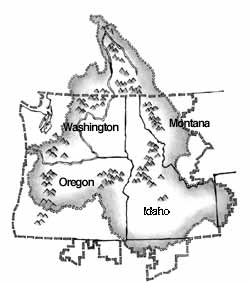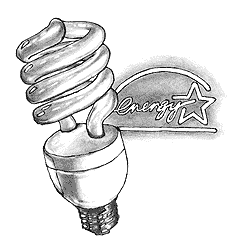Who Are We?

BPA: focusing on the Northwest
If you live in the Pacific Northwest, chances are you use electricity marketed and delivered by the Bonneville Power Administration – best known as BPA. BPA is a federal agency headquartered in Portland, Ore., that markets wholesale electricity and transmission to the Pacific Northwest’s public and private utilities as well as to some large industries.
BPA provides about half the electricity used in the Northwest and operates over three-fourths of the region’s high-voltage transmission.
While BPA is part of the Department of Energy, it is not tax-supported through government appropriations. Instead, BPA recovers all of its costs through sales of electricity and transmission and repays the U.S. Treasury in full with interest for any money it borrows.
Serving the public interest
Because BPA markets energy and transmission at cost, rather than at market prices, it has traditionally provided some of the lowest cost electricity in the nation. This low-cost power has been a cornerstone of the Northwest economy, stimulating growth and new jobs.
BPA also funds measures to protect and enhance fish and wildlife populations affected by hydropower development. In addition, the agency provides a number of public benefits including incentives for energy conservation programs and research and development of renewable resources and promising technologies, such as fuel cells.
BPA also works with other federal agencies to coordinate operations of the Federal Columbia River Power System to ensure maximum efficiency in the system and minimum environmental impacts.
Bringing power to the region
Congress and the Roosevelt Administration created BPA in 1937, just before completion of Bonneville and Grand Coulee dams in 1938 and 1941. They anticipated the need to market
energy from these new power sources. One of BPA’s early missions focused on electrifying farms and small communities with public power. These rural areas were not profitable for private utilities to serve.
 Today, BPA markets the power generated at 31 federal dams, one nonfederal nuclear plant at Hanford, Wash., and some nonfederal power plants, such as wind projects.
Today, BPA markets the power generated at 31 federal dams, one nonfederal nuclear plant at Hanford, Wash., and some nonfederal power plants, such as wind projects.
BPA’s service territory covers all of Washington, Oregon and Idaho, and western Montana, as well as small contiguous portions of California, Nevada, Utah, Wyoming and eastern Montana. BPA’s wholesale customers include public utilities, public utility districts, municipal districts, public cooperatives, some investor-owned utilities and a few large industries such as aluminum companies.
Some of these customers buy all their power from BPA, while others supplement their supply with nonfederal power. In years when the Northwest experiences heavy snow and rain, the Columbia River system can generate more electricity than BPA customers need. BPA offers this surplus energy to its Northwest customers first. Only then, if there are no takers, utilities and municipalities outside the region can buy it. Money generated from surplus sales helps keep power rates in the Northwest low.
Building the transmission network
 To deliver power, BPA began building transmission lines in the 1930s. The first line connected Bonneville Dam to Cascade Locks, just three miles from the dam. Major construction from the 1940s through the 1960s created networks and loops of high-voltage wire touching most parts of BPA’s service territory. The system now includes more than 15,000 miles of line and
300 substations.
To deliver power, BPA began building transmission lines in the 1930s. The first line connected Bonneville Dam to Cascade Locks, just three miles from the dam. Major construction from the 1940s through the 1960s created networks and loops of high-voltage wire touching most parts of BPA’s service territory. The system now includes more than 15,000 miles of line and
300 substations.
Dispatchers coordinate and monitor power flowing throughout the Northwest as well as
to other parts of the West, making sure that this complex, interconnected system runs smoothly.
In addition to the transmission network within the Northwest, BPA operates large interregional transmission lines that connect to Canada, California, the Southwest and eastern Montana. These transmission lines enable BPA to bring power into the region when it’s needed, such as on very cold winter days when there is high demand, and to sell power outside the region when it is surplus to the Northwest’s needs.
Balancing a river’s many uses
The vast bulk of the energy BPA markets comes from the Columbia River and its tributaries. However, there are many competing uses for the river’s resources. Important fish species make it their home. Some of them are resident fish, such as sturgeon, that spend their lives in the river or its tributaries. Others, such as salmon and steelhead, are born in the river’s freshwater but migrate to the ocean where they spend their adult lives before returning to spawn in their natal waters.
Ships and barges carry cargo to and from inland ports. Boats, water skiers and wind surfers skim the river’s surface. Hikers and sightseers enjoy the dramatic scenery. Irrigators draw its water to turn former desert into fertile croplands. Federal and nonfederal dams generate electricity, prevent floods and control its flow. Because these many uses can compete with each other, coordination of the river’s operations is an important role for BPA and its fellow federal operational agencies – the U.S. Army Corps of Engineers and Bureau of Reclamation. Together, these agencies operate the Federal Columbia River Power System.
Through a series of laws and agreements among many parties in the United States and with Canada (where the Columbia River originates), the river is operated as though run by a single entity. This ensures it is operated for maximum use with minimum environmental degradation. The federal agencies allocate water and coordinate releases from headwaters to provide for flood control, fish (especially protection of endangered species), energy, navigation and many other uses. This delicate balancing act requires constant and often challenging tradeoffs.
Forwarding conservation and renewables
While BPA relies on hydropower for its main power supply, energy conservation plays an increasingly important role. In the last 20 years , BPA has acquired more than 750 average megawatts of energy conservation, enough to serve a city the size of Portland, Ore., on an ongoing basis. BPA invests in energy conservation through projects that encourage use of energy-efficient technologies such as ultra-efficient compact fluorescent light bulbs. , BPA has acquired more than 750 average megawatts of energy conservation, enough to serve a city the size of Portland, Ore., on an ongoing basis. BPA invests in energy conservation through projects that encourage use of energy-efficient technologies such as ultra-efficient compact fluorescent light bulbs.
In partnership with other Northwest
utilities, BPA funds the Northwest Energy Efficiency Alliance, which works to bring new energy-efficient products into the marketplace. BPA supports the
U.S. Department of Energy’s Energy Star® program, which helps consumers choose energy-efficient products from televisions to washing machines. BPA also funds low-income weatherization.
BPA invests in new renewable generating resources for the Northwest such as wind and geothermal projects. BPA also works with the nonprofit and independent Bonneville Environmental Foundation to sell certified environmentally preferred power at a premium to interested buyers. The premium pays for still more investments in renewable resources, energy conservation and fish and wildlife protection.
Protecting fish and wildlife
BPA helps fund and manage the largest fish and wildlife program in the world. Along with overharvest, logging, farming and other human activities, hydro projects have affected fish and wildlife in the Columbia Basin. BPA works with other federal and state agencies and tribes on programs to address problems caused by federal dams.
 BPA is committed to working toward regional solutions based on sound biology. It funds about 500 fish and wildlife projects a year, from repairing spawning habitats to studying fish diseases and controlling predators. Projects for BPA funding are identified by the Northwest Power Planning Council’s fish and wildlife program and are reviewed by an independent scientific review panel.
BPA is committed to working toward regional solutions based on sound biology. It funds about 500 fish and wildlife projects a year, from repairing spawning habitats to studying fish diseases and controlling predators. Projects for BPA funding are identified by the Northwest Power Planning Council’s fish and wildlife program and are reviewed by an independent scientific review panel.
BPA and other federal agencies also work to protect and rebuild species listed under the Endangered Species Act. In most years, they release billions of gallons of water, once stored for winter power, from reservoirs each spring and early summer to speed the migration of young fish to the ocean and forego generation to spill water to help juvenile fish traverse the dams more safely. (The exception is in severe drought years where electricity reliability is threatened.)
Helping set your own energy destiny
As a public agency operating for public purposes, BPA encourages people to get involved in its activities and issues. BPA believes public involvement helps its managers make better decisions. BPA responds to multiple interests and regional concerns and makes its public policy decisions in an open public forum.
There are many ways to get involved.
For a start:
- Sign up for BPA’s monthly newsletter, the Journal, by contacting us at the number or address below;
- Look on the World Wide Web at
http://www.bpa.gov;
- Write:
BPA Public Affairs – DM-7
P.O. Box 3621
Portland, OR 97208-3621; or
- Call BPA’s Public Information Center
(503) 230-7334 or toll-free (800) 622-4520.
Bonneville Power Administration
P.O. Box 3621
Portland, Oregon 97208-3621
DOE/BP-3404 October 2001 4M
|
 About BPA
About BPA